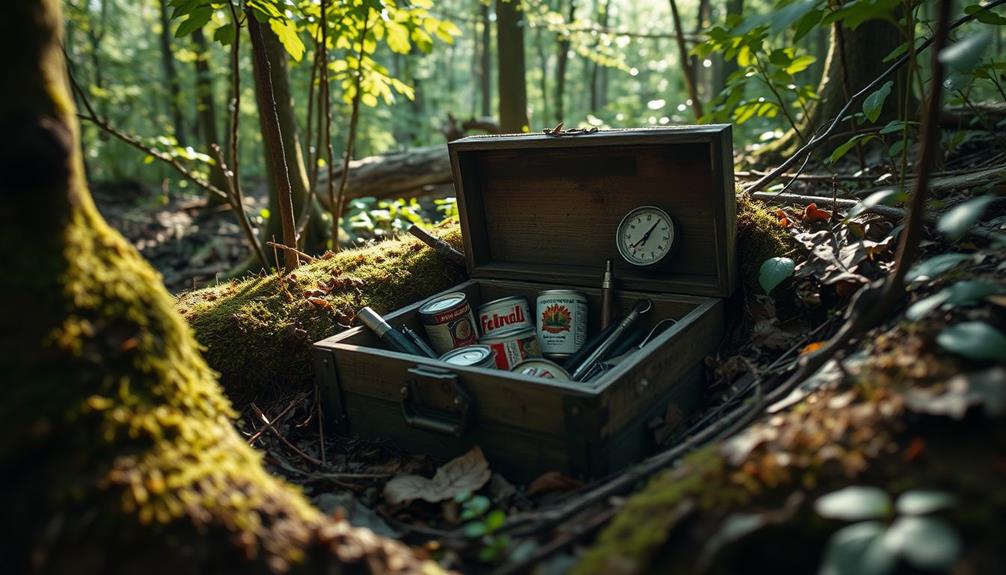To guarantee your family’s safety during emergencies, start by evaluating potential hazards around your home, like fire risks and fall hazards. Assemble an emergency kit stocked with non-perishable food, water, and a first aid kit. Install smoke detectors on every level and keep fire extinguishers accessible. Create a clear evacuation plan detailing escape routes and a meeting spot outside. Don’t forget to address any special needs in your household, from medications to pet supplies. By following these hacks, you’ll boost your preparedness and confidence. With a bit more insight, you can strengthen your emergency strategies even further. Consider reinforcing your home with safety measures like securing heavy furniture and appliances, and installing window locks and shatterproof glass. It’s also important to fortify your home against severe weather by sealing windows and doors, and investing in a generator for power outages. By taking these additional steps, you can further fortify your home and increase your family’s safety and security during emergencies.
Key Takeaways
- Create a well-stocked emergency kit with non-perishable food, water, first aid supplies, and essential medications tailored to your household's needs.
- Install smoke detectors and fire extinguishers in key areas, regularly test them, and maintain a written fire escape plan with marked exit routes.
- Ensure home safety by securing tall furniture, using non-slip mats, and keeping flammable items away from heat sources to prevent accidents.
- Establish clear communication and evacuation plans, designating safe meeting spots and practicing regularly to ensure all family members are prepared.
- Regularly review and update emergency supplies and plans to adapt to changing family needs and ensure effective response during emergencies.
Assessing Potential Hazards
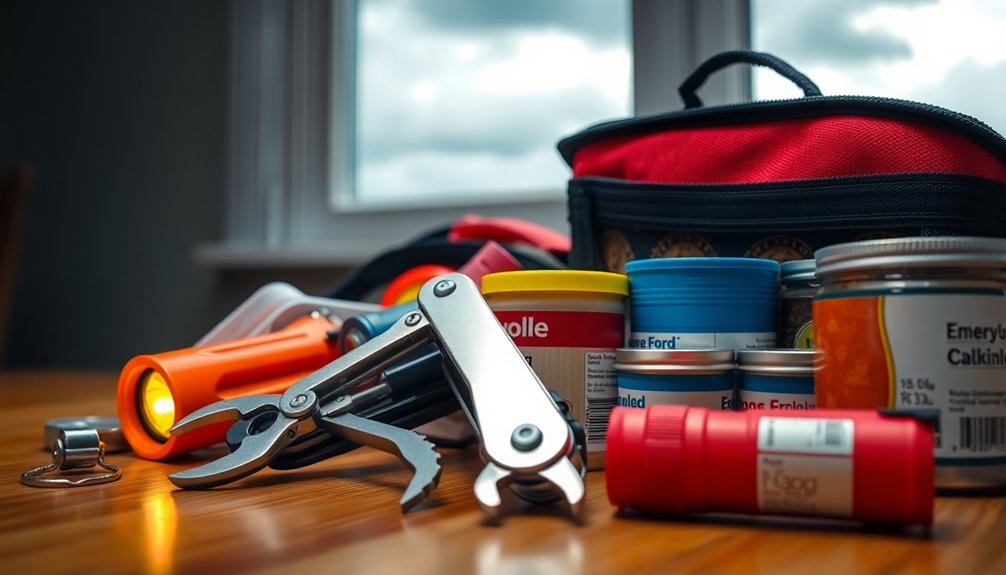
When it comes to keeping your home safe, evaluating potential hazards is crucial. Start by addressing fire hazards, which claim over 3,000 lives each year. Install smoke detectors in the kitchen, bedrooms, and basement, testing them monthly and replacing batteries twice a year. Keep flammable items at least three feet away from heat sources, and never leave cooking unattended. If a pan catches fire, use a damp tea towel, not water, to smother the flames.
Next, focus on fall and tripping hazards. Confirm staircases are well-lit and clutter-free. Install safety gates to keep young children safe. Use non-slip mats in bathrooms and secure furniture to walls to prevent tip-overs. Elderly individuals are particularly vulnerable to serious complications from falls, making it essential to assess and mitigate these risks. Regular screenings for early detection of potential health issues can also help prevent accidents related to chronic conditions.
Don't overlook poisoning and suffocation hazards. Install carbon monoxide detectors near sleeping areas and store chemicals out of children's reach in clearly labeled containers. Remove choking hazards, such as small toys and cords, from accessible areas.
Assembling Your Emergency Kit
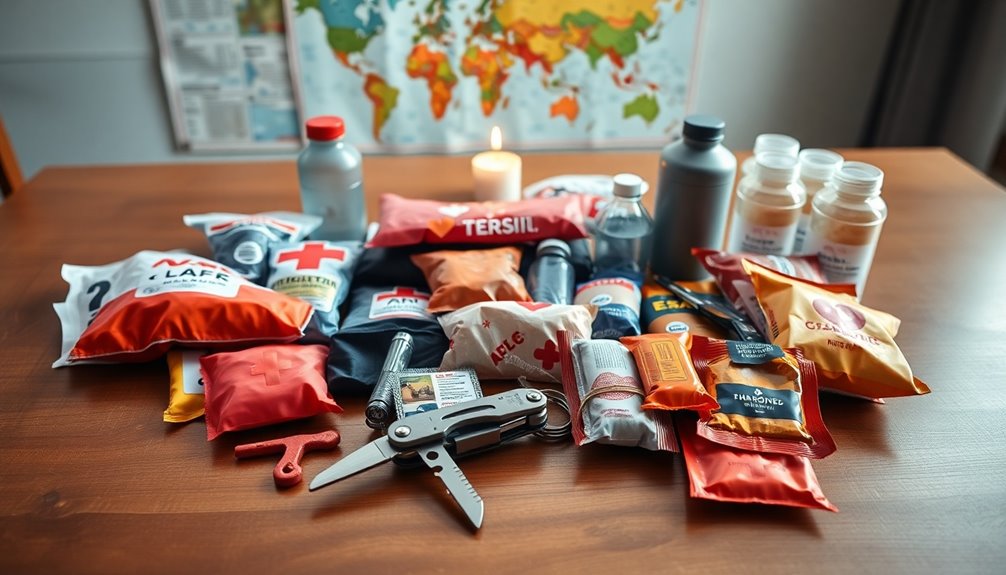
As you gather your emergency kit, start with a checklist of essential supplies to guarantee you're prepared for any situation. Think about any special considerations, like medical needs and personal preferences, that may affect what you include. Having a well-rounded kit can make all the difference when an emergency strikes. Regularly updating your kit ensures that you're equipped with relevant supplies that can effectively address any crisis.
Essential Supplies Checklist
Preparing for emergencies requires careful planning and the right supplies. An essential supplies checklist will help you stay organized and ready for anything life throws your way. Here's a quick rundown of must-have items for your emergency kit:
- Food and Water
- Stock at least a several-day supply of non-perishable food and one gallon of water per person per day. Don't forget a manual can opener! Additionally, having an air purifier can help maintain indoor air quality during emergencies by filtering out pollutants.
- First Aid and Medication
- Keep a basic first aid kit handy, along with prescription medications for at least a week. Include non-prescription meds like pain relievers, hand sanitizer, and disinfecting wipes.
- Communication and Lighting
- A battery-powered or hand-crank radio is vital for updates, so grab one if you can. Flashlights, extra batteries, and matches in a waterproof container are important for maintaining visibility and safety. Additionally, consider including a basic first aid kit that can address common injuries and health issues in emergencies.
Special Considerations Needed
Considering your unique household and environment is essential for assembling an effective emergency kit. Assess your living situation and the specific disasters that could occur in your area. Include items based on dietary preferences and verify you can replace perishables before they expire. Additionally, remember that having a survival kit enhances individual and community resilience during emergencies. Incorporating multi-functional gear can also help maximize space and ensure you have versatile tools at your disposal. It's important to include financial considerations in your emergency planning to ensure you can access essential resources when needed. Additionally, having a well-structured retirement savings plan can provide peace of mind during uncertain times.
Here's a quick table to help you visualize some crucial considerations:
| Consideration | Examples | Notes |
|---|---|---|
| Family Needs | Baby formula, pet food | Don't forget diapers! |
| Health Supplies | Prescription meds, first-aid kit | Stock at least a week's worth. |
| Unique Challenges | Disability aids, hygiene items | Tailor to individual needs. |
| Food & Water | Nutrient-dense bars, extra water | Consider shelf-life! |
| Accessibility | Portable kits, multiple locations | Everyone should know where! |
Be certain to store items in airtight bags and easy-to-carry containers. Regularly check and update your supplies as family needs change. By addressing these special considerations, you'll create a kit that truly meets your household's needs during emergencies.
Home Safety Precautions
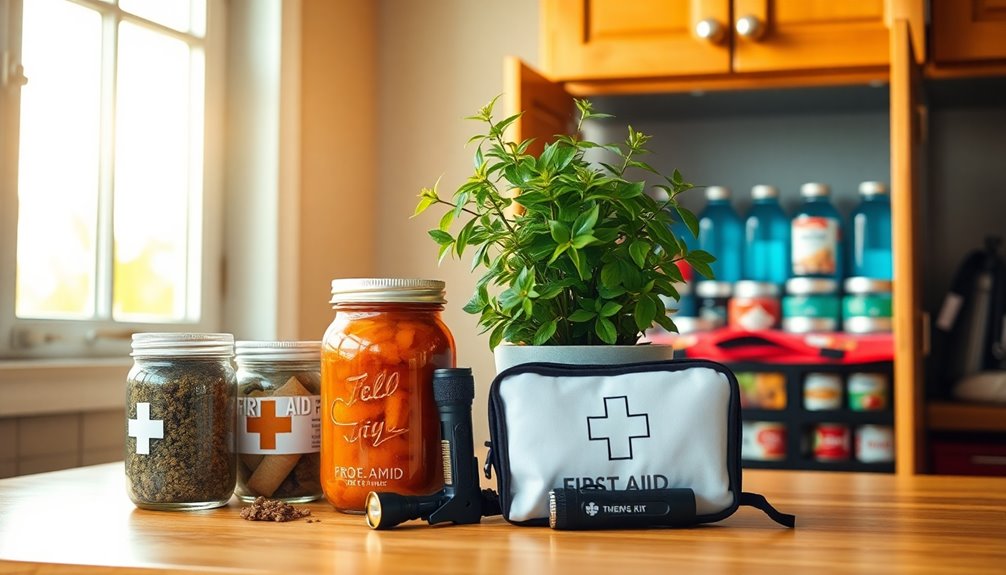
Home safety requires vigilance and proactive measures to protect your family from potential hazards. Start by guaranteeing your home is equipped with essential safety devices. Regular testing and maintenance will keep your family safe and informed.
Here are three key safety precautions to implement:
- Fire Safety: Install smoke alarms on every level and outside sleeping areas. Test them monthly and change the batteries twice a year. Keep fire extinguishers on every floor, especially in the kitchen, and practice a fire escape plan with your family. Additionally, ensure that your family is familiar with the escape planning process to improve preparedness. Regularly check the air quality indicators in your home to detect any potential hazards. Consider using air purifiers to reduce harmful pollutants and improve overall air quality.
- Electrical Safety: Avoid overloading outlets and use tamper-resistant receptacles. Install ground fault circuit interrupters (GFCIs) in wet areas to reduce the risk of electrical shock. Make sure to label circuit breakers for quick access during emergencies.
- General Safety: Install carbon monoxide detectors on every floor and keep stairways free of clutter. Secure tall furniture and use safety latches on cabinets to keep small children safe. Guarantee you set your water heater to no higher than 125º Fahrenheit to prevent scalding. Regular maintenance of your appliances can also prevent unexpected emergencies.
Effective Communication Plans
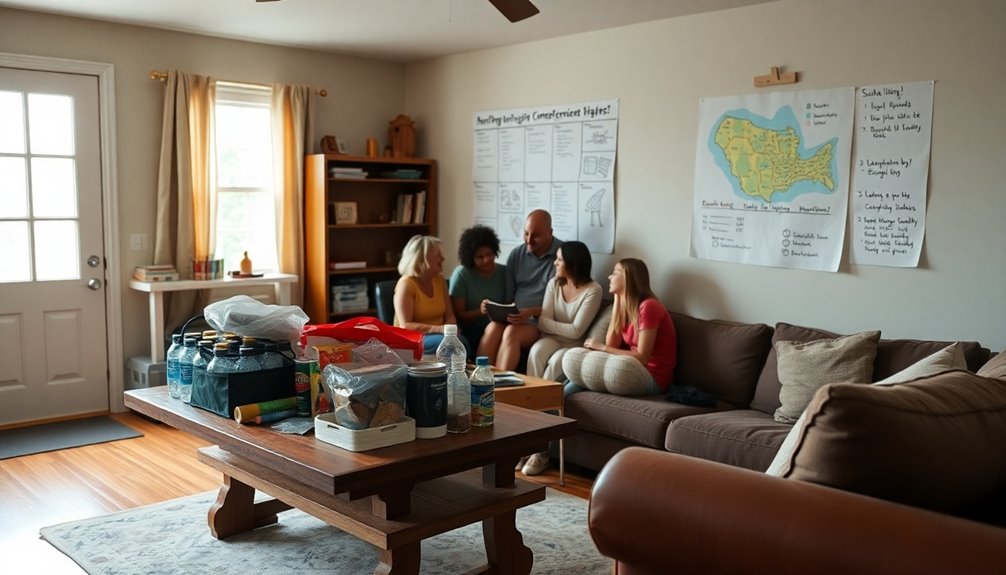
Effective communication plans are crucial in emergencies, guaranteeing everyone knows their roles and how to respond. You need to identify your organization's structure and the involved stakeholders, tailoring your strategies for different groups like employees, management, and external parties. This helps guarantee everyone receives the right information in a crisis. Additionally, investing in emergency mass notification software can enhance the speed and reliability of your communication efforts. Implementing a plan for positive reinforcement can also foster a collaborative atmosphere during emergencies. One way to ensure clarity is by utilizing essential survival skills to inform your communication strategies. Furthermore, establishing a home security system can provide peace of mind and enhance overall safety during emergencies.
Here's a simple overview of your communication plan:
| Role | Responsibilities | Contact Method |
|---|---|---|
| Group Admin | Oversee communication flow | Email, Phone |
| Emergency Responders | Implement safety measures | Text, Voice |
| Information Officer | Disseminate critical updates | Social Media, Email |
| Spokesperson | Serve as the primary communication voice | Press Releases, Interviews |
Assigning roles within your emergency communications team is crucial. Guarantee clear lines of communication between members and train them on their specific responsibilities. Develop and script precise messages tailored for various emergency scenarios. Finally, test your communication plan regularly to guarantee everyone can effectively perform their roles when it matters most.
Creating an Evacuation Strategy
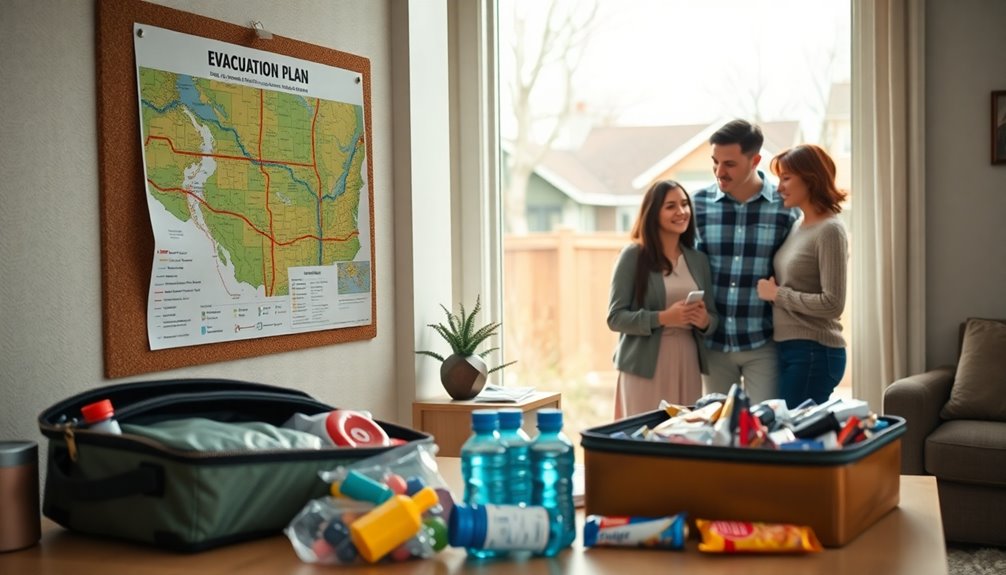
In emergencies, having a well-thought-out evacuation strategy can make all the difference in guaranteeing safety. Start by identifying escape routes throughout your home. You should find two ways out of every room, including windows and doors, ensuring they're clear of obstacles and easy to open. Install emergency release devices on any security bars and consider escape ladders for upper levels. Regular practice ensures your family's safety during a fire emergency.
Next, create a written home fire escape plan. Draw a map that marks exit routes and smoke detector locations, and practice this plan regularly. Discuss it with everyone in your household to guarantee everyone understands their role.
Finally, designate a safe meeting spot outside your home where everyone knows to gather after evacuating. This spot should be visible to emergency responders and a safe distance from the house. Teach your children the importance of not going back inside once they've left.
Here's a quick checklist to help you:
- Identify and clear escape routes in every room.
- Create and practice a written evacuation plan.
- Designate and teach the meeting spot to all household members.
Preparation is key to staying safe during emergencies!
Addressing Special Needs
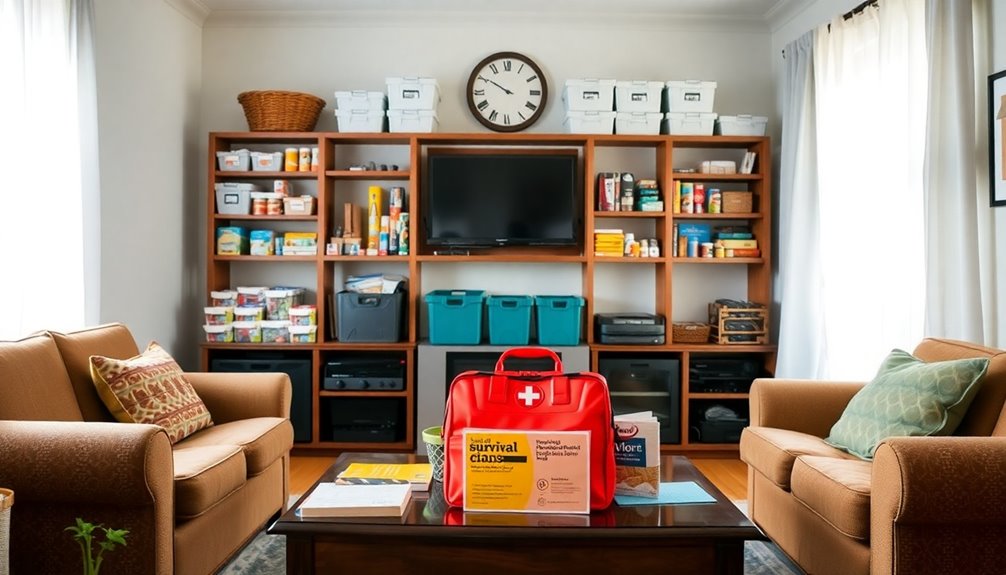
When emergencies strike, addressing special needs within your family is essential for guaranteeing everyone's safety. Start by incorporating specific needs into your family preparedness plan. Document individual requirements, including medications, equipment, and communication methods. Keep a thorough list of emergency contacts and medical information handy.
As you assemble your disaster supply kit, include personal supplies tailored to each person's needs. Stock extra wheelchair batteries, oxygen, catheters, and any essentials. Use Braille labels or large print for emergency supplies to assist those with visual impairments. For family members who are deaf or hard of hearing, make certain you have a weather radio with a text display and flashing alert feature. It's important to remember that additional lead time may be required for effective preparation.
Establish a support network of family, friends, and neighbors who can help during a disaster. Make sure they're aware of individual needs and capabilities. Register with local emergency services and disability organizations for added support. Inform your network about where emergency supplies are stored and provide access keys if necessary.
Lastly, prepare for potential power outages by finding alternative charging methods for medical equipment and keeping backup power supplies on hand. Always have a manual wheelchair available as a backup to power wheelchairs.
Frequently Asked Questions
How Often Should I Update My Emergency Plan?
You should update your emergency plan at least once a year to keep it relevant. However, if you make any changes to your home, like renovations or new appliances, it's vital to review it sooner. Additionally, after any drills or real emergencies, gather feedback and refine your plan. Regularly check that contact details and evacuation procedures are accurate, ensuring everyone knows what to do when an emergency strikes.
What Is the Best Way to Store Water Long-Term?
To store water long-term, use food-grade plastic, glass, or stainless steel containers, avoiding those previously used for toxic substances. Keep your containers in a cool, dark place, away from sunlight and chemicals. Treat tap water with chlorine for safety, and rotate your supply every six months to guarantee freshness. Label each container clearly as drinking water, and maintain proper sealing to prevent contamination. Regular checks will help keep your water safe and ready.
How Can I Prepare for Power Outages?
When power outages strike, you want to be as ready as a superhero! Start by keeping torches and spare batteries handy, ditching those dangerous candles. Charge your mobile devices and have a battery-operated radio for updates. Stock up on non-perishable food and at least a gallon of water per person daily. Don't forget to check your carbon monoxide detectors and have a first aid kit ready; you never know when you'll need it!
What Should I Include for Pets in My Emergency Kit?
When preparing your emergency kit for pets, start by including at least one to two weeks' worth of food and water. Don't forget collapsible bowls and a full supply of medications, along with instructions. Add a first aid kit, vaccination records, and recent photos of your pet. Keep a leash, collar with ID, and comfort items like blankets or toys handy. Finally, gather emergency contacts and vet information to stay organized.
How Do I Teach Children About Emergency Preparedness?
Imagine a brave knight facing a fierce dragon; your kids can be those knights! Teach them about emergency preparedness by turning lessons into adventures. Use stories to explain different emergencies, and create fun drills to practice. Equip them with knowledge about calling 911 and identifying safe spaces. Regularly review the plan, making it a family quest. By fostering confidence, they'll feel empowered to navigate any storm that comes their way.
Conclusion
By taking these steps, you're not just preparing for emergencies; you're gearing up to face any disaster like a superhero! With a well-thought-out plan, a stocked emergency kit, and a clear communication strategy, you can tackle whatever comes your way. Remember, even the smallest actions can make a world of difference when chaos strikes. So, roll up your sleeves, stay proactive, and you'll be ready to keep your home safe and sound in any situation!





